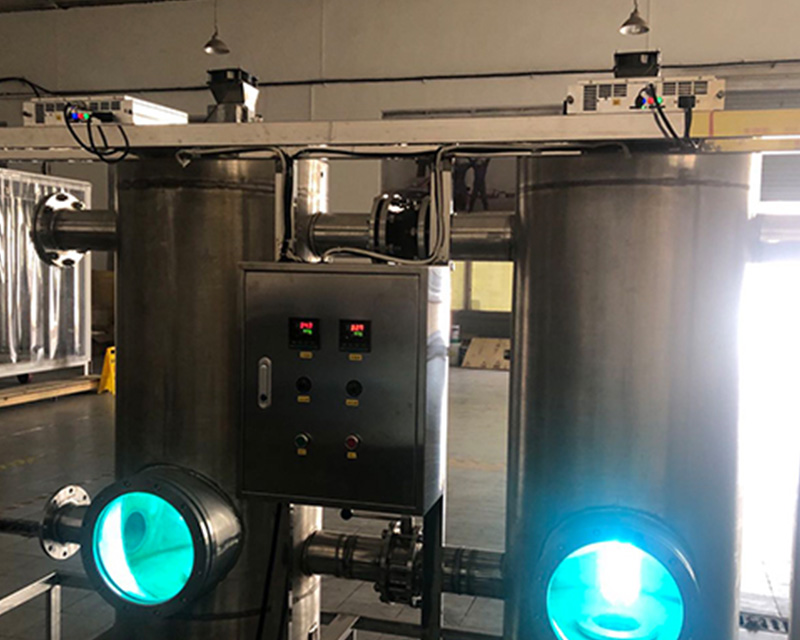(1) Microwave sewage treatment process
The microwave sewage treatment process is different from the traditional sewage treatment process. Its advantages are that the process flow is greatly simplified, and a large number of pipe network projects are reduced. There are no special requirements for the pH, concentration, temperature, etc. of the incoming water. The process flow diagram is shown in the following figure.
Description of microwave sewage treatment process:
1. Grid: (for water quality with large particles, such as urban domestic sewage), remove large debris such as sand, wood, plastic, etc;
2. Regulating tank: regulate water quantity and quality to reduce impact load on subsequent treatment structures;
3. Mixer: fully mix and shake the sewage with the 1 # and 2 # additives;
4. Microwave reactor: Physicochemical reaction between pollutants and additives and physicochemical reaction catalyzed by microwave at low temperature;
5. Integrated equipment of sedimentation and filtration: realize solid-liquid separation, achieve the purpose of discharge or reuse, and sludge is dewatered and transported outside or used for other purposes.
Under the joint action of additives and microwave, pollutants in water undergo intense catalytic, physical and chemical reactions, and are converted into insoluble substances or gases are separated from water. Macromolecules and refractory organic pollutants in water are decomposed into small molecules under the joint action of microwave and additives, and are combined with additives to form fast settling flocs for removal; Metal ions can be directly combined with additives to form fast settling flocs; Ammonia nitrogen is converted into ammonia gas and escapes; Phosphorus in water is converted to insoluble phosphate for precipitation and removal.
(2) Technical characteristics of microwave sewage treatment
Microwave sewage treatment technology is not a method in the field of water treatment, but because of its reliability, stability, breakthrough, broad-spectrum and many other advantages, it can be used as a water treatment method. It has incomparable advantages over other traditional water treatment methods:
1. The process flow is short, the flocculation sedimentation speed is fast, and the floor area is small. The project of using microwave sewage treatment technology to treat 2400 tons of water per day covers less than 300m2 in total, of which the microwave energy water treatment unit equipment only covers 64m2, about 1/6-1/10 of the ordinary activated sludge process (the total area of traditional methods is more than 2000m2).
2. The project investment intensity is low and the construction period is short. Due to the uniqueness of the equipment itself, it is unnecessary to lay huge pipe networks and pools, and the civil engineering is simple; The equipment is compact in structure and assembled in blocks. The construction and installation are fast and convenient, greatly shortening the construction period, and the daily processing capacity is 2400m ³ The engineering installation of a single unit can be completed in about half a month. When the equipment is running, the hourly power consumption is only 40 degrees, which is equivalent to 0.4 degrees per ton of water. The calculated comprehensive operating cost is about 0.5~1.2 yuan per ton of water.
3. The commissioning cycle is short. Due to the short process flow of microwave sewage treatment technology, there is no complicated commissioning and online commissioning stage of multiple units. Generally, the commissioning process only takes a few days to enter into continuous operation.
4. Strong ability to kill bacteria and algae. Microwave has a high frequency penetration effect on bacteria and algae, with extremely strong killing capacity. It can kill microorganisms in a short time, and has a strong sterilization and algae killing function. In the microwave field, cyanobacteria only need a very short time, that is, from micro fine particles to large particles, turn yellow, settle and separate from water.
5. Strong adaptability and high processing efficiency. Microwave sewage treatment technology can be widely used in municipal sewage, industrial wastewater, residential water reuse and other industries, and can be applied as part of any process. Microwave sewage treatment technology can realize the continuous reuse of sewage, and the effluent can be discharged or reused up to the standard.
